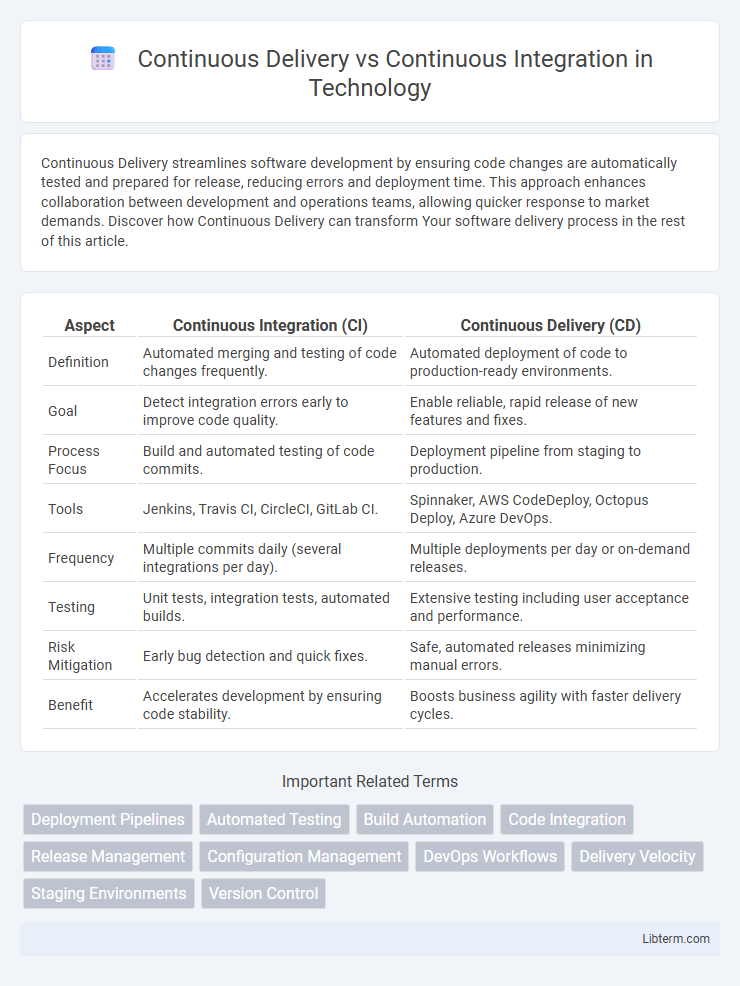Continuous Delivery streamlines software development by ensuring code changes are automatically tested and prepared for release, reducing errors and deployment time. This approach enhances collaboration between development and operations teams, allowing quicker response to market demands. Discover how Continuous Delivery can transform Your software delivery process in the rest of this article.
Table of Comparison
| Aspect | Continuous Integration (CI) | Continuous Delivery (CD) |
|---|---|---|
| Definition | Automated merging and testing of code changes frequently. | Automated deployment of code to production-ready environments. |
| Goal | Detect integration errors early to improve code quality. | Enable reliable, rapid release of new features and fixes. |
| Process Focus | Build and automated testing of code commits. | Deployment pipeline from staging to production. |
| Tools | Jenkins, Travis CI, CircleCI, GitLab CI. | Spinnaker, AWS CodeDeploy, Octopus Deploy, Azure DevOps. |
| Frequency | Multiple commits daily (several integrations per day). | Multiple deployments per day or on-demand releases. |
| Testing | Unit tests, integration tests, automated builds. | Extensive testing including user acceptance and performance. |
| Risk Mitigation | Early bug detection and quick fixes. | Safe, automated releases minimizing manual errors. |
| Benefit | Accelerates development by ensuring code stability. | Boosts business agility with faster delivery cycles. |
Understanding Continuous Integration (CI)
Continuous Integration (CI) is a software development practice where developers frequently merge code changes into a shared repository, triggering automated builds and tests to detect integration errors early. CI tools like Jenkins, Travis CI, and CircleCI streamline this process by ensuring code quality, reducing integration issues, and accelerating development cycles. By maintaining a consistent and reliable codebase, CI forms the foundation for Continuous Delivery (CD) by enabling rapid and reliable software releases.
Exploring Continuous Delivery (CD)
Continuous Delivery (CD) is a software development practice that ensures code changes are automatically tested and prepared for release to production, enabling faster and more reliable deployments. Unlike Continuous Integration (CI), which focuses on merging and validating code changes frequently, CD emphasizes automating the entire release pipeline, allowing teams to deploy updates to users with minimal manual intervention. Implementing Continuous Delivery improves software quality, reduces deployment risks, and accelerates time-to-market by maintaining readiness for production deployment at any moment.
Key Differences Between CI and CD
Continuous Integration (CI) emphasizes frequent code integration into a shared repository, triggering automated tests to detect errors early, while Continuous Delivery (CD) extends CI by automating the deployment process to production-ready environments. Key differences include CI's focus on code quality and early bug detection through build and test automation, whereas CD ensures that code changes are reliably and quickly delivered to production with minimal manual intervention. CI is primarily about integration and validation, whereas CD encompasses deployment automation and release readiness.
Core Benefits of Continuous Integration
Continuous Integration (CI) accelerates software development by automatically merging code changes from multiple contributors into a shared repository several times a day, enabling early detection of integration errors. Core benefits include improved code quality through automated testing, reduced merge conflicts, and faster feedback loops that enhance developer productivity and collaboration. CI supports a stable codebase, minimizes bugs in production, and facilitates smoother Continuous Delivery pipelines by ensuring reliable builds.
Advantages of Continuous Delivery
Continuous Delivery automates the deployment pipeline, enabling faster and more reliable software releases with reduced manual intervention. This approach minimizes deployment risks, improves product quality through frequent testing, and allows teams to respond quickly to market demands. Enhanced collaboration between development and operations also leads to increased efficiency and continuous feedback integration.
Typical CI/CD Workflow Explained
Typical CI/CD workflow begins with Continuous Integration, where developers frequently merge code changes into a shared repository, triggering automated builds and tests that ensure code quality and detect bugs early. Continuous Delivery extends this process by automatically deploying validated code to staging environments, enabling rapid feedback and facilitating seamless releases to production with minimal manual intervention. This integration of Continuous Integration and Continuous Delivery streamlines development cycles, reduces deployment risks, and enhances software reliability.
Common Tools for CI and CD
Jenkins, GitLab CI, and Travis CI are among the most popular tools for Continuous Integration, enabling automated code testing and integration. For Continuous Delivery, tools like Spinnaker, Octopus Deploy, and Bamboo facilitate automated deployment pipelines and release management. Many platforms, such as Azure DevOps and CircleCI, offer integrated solutions supporting both CI and CD processes for streamlined DevOps workflows.
Challenges of Implementing CI and CD
Implementing Continuous Integration (CI) and Continuous Delivery (CD) faces challenges such as toolchain integration complexity, requiring seamless coordination between diverse development, testing, and deployment tools. Ensuring consistent and reliable automated testing pipelines demands significant effort to avoid false positives and negatives that can disrupt delivery flow. Cultural resistance and lack of expertise in DevOps practices often hinder adopting CI/CD, necessitating ongoing training and organizational change management.
Best Practices for CI/CD Success
Continuous Integration (CI) best practices involve automating code integration multiple times a day, running comprehensive unit tests, and maintaining a shared repository to detect defects early. Continuous Delivery (CD) emphasizes automated deployment pipelines, ensuring that every code change is production-ready and can be released reliably at any time. Implementing version control, automated testing, and consistent monitoring are critical for achieving successful CI/CD workflows.
Choosing the Right Approach: CI, CD, or Both?
Choosing between Continuous Integration (CI) and Continuous Delivery (CD) depends on your development cycle needs and release frequency; CI focuses on automated testing and integration of code changes, while CD extends this by automating deployment to production. Organizations aiming for rapid, reliable releases benefit from implementing both CI and CD, enabling streamlined workflows and minimizing manual intervention. Evaluating project complexity, team expertise, and deployment risks guides the optimal adoption of CI, CD, or a combined pipeline for efficient software delivery.
Continuous Delivery Infographic

 libterm.com
libterm.com